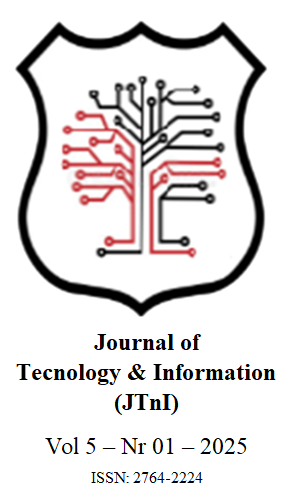Application of Generative Adversary Networks in the Detection and Prevention of Cyber Attacks
Keywords:
PortuguêsAbstract
This paper investigates the use of Generative Adversary Networks (GANs) as a tool to strengthen cyber security, specifically in the detection of malicious access. Using a case study in a controlled environment, we analyze the effectiveness of GANs in distinguishing between legitimate accesses and intrusion attempts, with a focus on protecting the integrity of information systems. The methodology used is Case Study, included collecting data from a network system, building and training GAN and Machine Learning (ML) models, and analyzing key hyperparameters, such as loss function and learning rate, to optimize model performance. The results show the potential of GANs to complement security systems, reinforcing their robustness against brute force attacks and other threats. This study contributes to research into the application of GANs in information security, highlighting the role of artificial intelligence in defending corporate networks.
References
ADIBAN, M.; SINISCALCHI, M. S.; SALVI, G. 2023. A step-by-step training method for multi generator GANs with application to anomaly detection and cybersecurity. Disponível em: https://www.sciencedirect.com/science/article/pii/S0925231223003065.
ALMEIDA. C.C. 2019. Identificação e classificação de imagens usando rede neural convolucional e "machine learning" [recurso eletrônico]: implementação em sistema embarcado. Disponivel em: https://repositorio.unicamp.br/acervo/detalhe/1126679.
ALQAHTANI, H.; KAVAKLI, M.; AHUJA, G. 2019. Applications of Generative Adversarial Networks (GANs): An Updated Review. Disponível em: https://www.researchgate.net/publication/338050169_Applications_of_Generative_Adversarial_Networks_GANs_An_Updated_Review.
ARORA, A SHANTANU. 2020. A Review on Application of GANs in Cybersecurity Domain. Disponível em: https://www.tandfonline.com/doi/full/10.1080/02564602.2020.1854058?scroll=top&needAccess=true.
AWS. 2023. O que é uma GAN? Disponível em: https://aws.amazon.com/pt/what-is/gan/
BROWN, A.; TUOR, A; HUTCHINSON, B.; NICHOLS, N. 2018. Recurrent Neural Network Attention Mechanisms for Interpretable System Log Anomaly Detection. Disponível em: https://dl.acm.org/doi/abs/10.1145/3217871.3217872.
CISCO. 2017. DHCP Overview. Disponível em: https://www.cisco.com/c/en/us/td/docs/routers/ncs4200/configuration/guide/IP/17-1-1/b-dhcp-17-1-1-ncs4200/b-dhcp-17-1-1-ncs4200_chapter_00.pdf.
CISCO. 2024. What is SD-WAN? Cisco. Disponível em: https://www.cisco.com/c/en/us/solutions/enterprise-networks/sd-wan/what-is-sd-wan.html.
DATA SCIENCE ACADEMY. 2022. Deep Learning Book. Disponível em: https://www.deeplearningbook.com.br/.
FONTANA, G & CARNEIRO, F. R.P. 2023. Estudo do impacto da variação de parâmetros em uma rede neural artificial aplicado a bases com diferentes características. Disponivel em: https://ri.unipac.br/repositorio/wp-content/uploads/tainacan-items/282/224732/GUILHERME-FONTANA-KILSON-ESTUDO-DO-IMPACTO-DA-VARIACAO-DE-PARAMETROS-EM-UMA-REDE-COMPUTACAO-2023.pdf.
GALEGALE, N.; FONTES, E.; GALEGALE, B. 2017. Uma contribuição para a Segurança da Informação: um estudo de casos múltiplos com organizações brasileiras. Disponível em: https://www.scielo.br/j/pci/a/Srp97XX3Hyb4MfjxRH9gDgd/#.
GOODFELLOW, I. J.; BENGIO, Y.; COURVILLE, A. 2017. Deep Learning. Disponível em: https://link.springer.com/article/10.1007/s10710-017-9314-z.
GOODFELLOW, I. J.; POUGET-ABADIE. J.; MIRZA, M.; XU, B.; WARDE-FARLEY D.; OZAIR, S.; COURVILLE, A; BENGIO, Y. 2014. Generative Adversarial Nets. Disponível em: https://arxiv.org/abs/1406.2661.
HAYKIN, S. 1998. Neural Networks: A Comprehensive Foundation. Disponível em: https://dl.acm.org/doi/abs/10.5555/521706.
HOSAKI, G. Y. & RIBEIRO, D. F. 2021. Deep learning: ensinando a aprender. Disponivel em: https://ric.cps.sp.gov.br/handle/123456789/5060.
JANIESCH, C.; ZSCHECH, P.; HEINRICH, K. 2021. Machine learning and deep learning. Disponível em: https://link.springer.com/article/10.1007/s12525-021-00475-2.
KASPERSKY, 2022. Relatório da Kaspersky revela como ocorreram os ataques de ransomware em 2022. Disponivel em: https://www.kaspersky.com.br/about/press-releases/43-dos-ataques-de-ransomware-em-2022-comecaram-com-a-exploracao-de-aplicativos.
KHARISMADHANY, E.; RUSWIANSARI, M.; HARSONO, T. 2023. Brute-force Detection Using Ensemble Classification Disponível em: https://www.researchgate.net/publication/382373555_Brute-force_Detection_Using_Ensemble_Classification.
KOCH, B.; DENTON, E.; HANNA, A.; FOSTER, J. G. 2021. Reduced, Reused and Recycled: The Life of a Dataset in Machine Learning Research. Disponível em: https://par.nsf.gov/biblio/10324721-reduced-reused-recycled-life-dataset-machine-learning-research.
LECUN, Y.; BENGIO, Y.; HINTON, G. 2015. Deep learning. Disponível em: https://www.nature.com/articles/nature14539.
LIPPMANN, RICHARD.; HAINES, J. W.; FRIED. J. D.; KORBA, J.; DAS. K. 2000. The 1999 DARPA off-line intrusion detection evaluation. Disponível em: https://www.sciencedirect.com/science/article/abs/pii/S1389128600001390.
LUCIC. M.; KURACH. K.; MICHALSKI. M.; GELLY. S.; BOUSQUET. O. 2017. Are GANs Created Equal? A Large-Scale Study. Disponível em: https://arxiv.org/abs/1711.10337.
MARTINIANO. A.; FERREIRA. R. P.; FERREIRA. A.; FERREIRA. A.; SASSI. R. J. 2016. Utilizando uma rede neural artificial para aproximação da função de evolução do sistema de Lorentz. Disponível em: https://www.researchgate.net/figure/Figura-1-Representacao-do-neuronio-artificial_fig1_329245206/actions#caption.
MIRZA, M. & OSINDERO, S. 2014. Conditional Generative Adversarial Nets. Disponível em: https://arxiv.org/abs/1411.1784.
MONARD, M. C & BARANAUSKAS, J. A. 2003. Conceitos sobre Aprendizado de Máquina. Disponível em: https://dcm.ffclrp.usp.br/~augusto/publications/2003-sistemas-inteligentes-cap4.pdf.
NAJAFABADI. M. M.; KHOSHGOFTAAR. T. M.; KEMP. C.; SELIYA. N.; ZUECH. R. 2014. Machine Learning for Detecting Brute Force Attacks at the Network Level. Disponível em: https://ieeexplore.ieee.org/document/7033609.
NOOR. S.; BAZAI. S. U.; GHAFOOR. M. I.; MARJAN. S.; AKRAM. S.; ALI. F. 2023. Generative Adversarial Networks for Anomaly Detection: A Systematic Literature Review. Disponível em: https://www.researchgate.net/publication/370177350_Generative_Adversarial_Networks_for_Anomaly_Detection_A_Systematic_Literature_Review.
PEREIRA. H. A.; DE SOUZA. A. F.; DE MENEZES. C. S. 2018. Obtaining evidence of learning in digital games through a deep learning neural network to classify facial expressions of the players. IEEE Transactions on Computational Intelligence and AI in Games, 2019. Disponível em: https://ieeexplore.ieee.org/abstract/document/8659216
POWERS. D. M. W. 2020. Evaluation: from precision, recall and F-measure to ROC, informedness, markedness and correlation. Disponível em: https://arxiv.org/abs/2010.16061.
SALAMA, S.; ALAMOUDI, Y.; ALAMOUDI, G.; ALBESHRI, F. 2023. Cloud Computing Security Issues and Countermeasure: A Comprehensive Survey. Disponível em: https://www.ijcaonline.org/archives/volume185/number14/32767-2023922832/.
SCARFONE, K. & MELL, P. 2007. Guide to Intrusion Detection and Prevention Systems (IDPS) Disponível em: https://csrc.nist.gov/pubs/sp/800/94/final.
SIEMURI, A.; SELVAN, K.; KUUSNIEMI, H.; VALISUO, P.; ELMUSRATI, M. S. 2022. A Systematic Review of Machine Learning Techniques for GNSS Use Cases. Disponível em: https://ieeexplore.ieee.org/stamp/stamp.jsp?tp=&arnumber=9937069.
SOMMER. R & PAXSON, V. 2010. Outside the Closed World:On Using Machine Learning for Network Intrusion Detection. Disponível em: https://ieeexplore.ieee.org/document/5504793.
WANG, Z.; SHE, Q.; WARD, T. E. 2020. Generative Adversarial Networks in Computer Vision: A Survey and Taxonomy. Disponível em: https://arxiv.org/abs/1906.01529.












